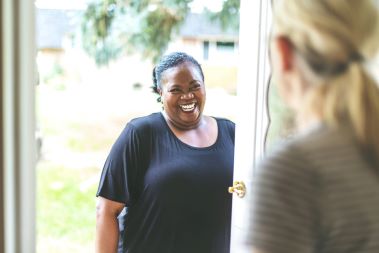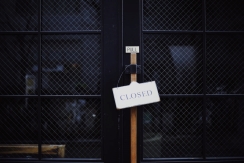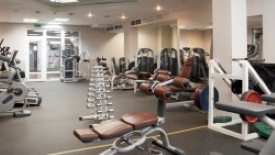

Stand together: Kindness and resilience make for stronger communities
by Amy Repke

Neighbors helping neighbors. That’s what makes community associations special. Whether you’re delivering meals, collecting donations, grocery shopping for an elderly resident, or calling to check on a quarantined neighbor, every act of kindness helps. We know that behind every successful community, there are dedicated homeowner leaders, community managers, and business partners working daily to assist residents and offer solutions.
We applaud the actions we are witnessing by community associations across the globe. During these challenging times, we are seeing the true strength and perseverance of humanity. We understand that first responders and healthcare workers are on the frontlines battling this catastrophic virus, but we need to do our part to inform, educate, help stop the spread of COVID-19, and help others.
As each day brings new information, it’s important for community associations to realize the role they play. While tensions run high, it’s essential to set a higher standard for the way community residents respond to difficult changes. Let’s take the time to say thank you to the people who are working tirelessly in our communities to find medical masks for residents, answer calls in the office, clean the elevators and common areas, or visit a dozen retail outlets just to find paper products for the community.
We know successful communities need homeowners, managers, and business partners to work together. We need each other now more than ever. Understanding that the situation is changing quickly, the decisions made today can have a lasting impact on our communities tomorrow. A good place to start: Look for ways you can help, and say thank you to your community’s volunteers, staff, and business partners.
_____________________________________________________

Continuity and closures: How community associations are addressing COVID-19
by Kiara Candelaria

Ensuring continuity of operations and residents’ safety has become top of mind for community association board members, managers, and business partners as the COVID-19 outbreak begins to impact more and more of the U.S.
Donna DiMaggio Berger, a shareholder with Becker in Fort Lauderdale, Fla., and a fellow in CAI’s College of Community Association Lawyers (CCAL), says her law firm has been providing counsel to association boards on conducting meetings remotely and minimizing residents’ exposure to the coronavirus. She has advised boards to postpone nonessential meetings and events and limit person-to-person contact by practicing social distancing.
The Centers for Disease Control and Prevention describes social distancing as staying away from mass gatherings and keeping 6 feet—about one body length—away from others. This practice restricts where people can gather and can slow or stop the spread of an infectious disease.
For community association residents, that means maintaining a safe distance in elevators, corridors, laundry facilities, and other enclosed spaces, according to Berger.
Management company executives also have been communicating with association boards on adopting preventive measures to mitigate the risk of COVID-19 in their communities.
Sergey A. Petrov, CMCA, AMS, PCAM, CEO of Yalnes, Inc., in Seattle, says he is postponing all in-person meetings, site visits, and other events requiring person-to-person contact until the end of March. He is encouraging boards of directors to do the same and to follow guidance from the CDC and the Washington State Department of Health. He also is allowing flexibility for employees to work remotely.
Stephen J. Sulkey, CMCA, AMS, PCAM, founder of Professional Association Management in Wilmington, N.C., recommends that association boards follow guidance from health officials, instruct contractors to clean frequently touched surfaces, and continue communicating the importance of handwashing and social distancing.
“If your homeowners association has a clubhouse, pool, or other public place, you may want to shut them down if someone in your community is infected,” Sulkey states in a recent email sent to all board members. He also would communicate if there were any disruptions to maintenance and upkeep services if workers become sick.
Much like the rest of the world, community associations and their residents are facing a challenge they’ve never before experienced. The questions they’re asking and actions they’re taking are unique but warranted.
“I’m heartened by the amount of care and concern boards and their professional management are displaying during this crisis,” says Berger. “It’s important for residents to work with their boards and managers by adhering to new protocols that are put in place and by self-reporting and self-quarantining if necessary.”
________________________________________________________________
Holding HOAs Meetings Virtually Because of COVID-19 By Laura Otto

As teleworking becomes the new norm during the COVID-19 pandemic, there are several methods by which association members or association boards can transact business in the absence of everyone gathering at the same time and location.
Virtual meetings help associations conduct business when not all members can be physically present. Tools such as Skype, GoToMeeting and Google Plus Hangouts allow board members to hear each other through microphones and speakers and to see each other through video cameras regardless of where they are located. And that old standby—the telephone conference call—remains popular and legal for board meetings, even though it doesn’t allow participants to see each other, documents or other materials.
A variety of state provisions set out how association meetings can and cannot be conducted in the electronic age. Some statutes and regulations that cover corporations and nonprofit organizations apply to associations as well.
Experts advise association leaders to discuss options with legal counsel before deciding on a form of meeting technology and how to deploy it. In general, most board deliberations and decisions must be held in a fashion that allows board members to talk to one another contemporaneously and property owners to hear that discussion in real time.
Some state laws require that association committee meetings also be open to physical attendance or electronic monitoring. Some measures dictate that property owners attending board meetings be given the opportunity to address the board, as well as to listen to deliberations. And some statutes permit boards to vote by email in certain circumstances and to ratify such a vote in a subsequent public meeting.
Laws Pertaining to Virtual Attendees
Rules and regulations on this issue vary from state to state. We strongly recommend HOA’s review state laws in the event they prohibit virtual attendance at nonprofit board meetings.
Bylaws
If your state does not prohibit virtual attendance, ensure that your association bylaws do not prohibit it either.
Virtual Meeting Tips and Resources
For participants calling in:
- Announce yourself when you join and rejoin a meeting.
- Mute your phone if you need to cough or speak to someone at your location.
- Mute your phone if there is background noise, such as in an airport.
- Turn off your television, radio and cellphone if it isn’t being used for the call.
- When you speak, state your first name each time unless you are the only person who called in.
- If you need to “leave” the meeting, inform everyone.
- Smile when you speak; it comes through in your voice.
Below is a list of possible systems board members can use to hold a virtual meeting.
________________________________________________________________
Closing Common Areas in HOAs Due to COVID-19 By Wil Washington

Can we close our gym, business center or other shared facility because of COVID-19?
The answer is yes. As the number of COVID-19 cases increases nationwide, many boards are faced with a difficult business decision — should we (and can we) close common facilities? Indeed, most governing documents provide clear authority to the board to “operate, manage, and supervise” common facilities, which could include suspending their operation.
If the board believes that closing a gym, business center or community room is in the interest of the health and safety of residents to minimize the spread of disease, this is arguably a defensible, sensible business decision under the governing documents. If a board makes this kind of decision, we recommend making the rationale clear in a written communication to the members.
Common Areas
Associations do have the option to close common facilities if the board believes it is in the interests of the residents. For areas that remain open, remember that viruses may be able to transmit via contaminated surfaces. While an association has limited ability to reasonably sterilize all common areas, there are some steps that can be taken to improve the sanitary situation on certain common area facilities and equipment. For example:
Enhanced Cleaning. Association cleaning contractors or employees can undertake more extensive cleaning or wiping down of common area surfaces and equipment, elevator surfaces and other areas.
Close Facilities. The association may even consider temporarily closing certain areas/facilities where germs/viruses are easily spread, such as gyms.
Postpone Events. If there are events scheduled in the midst of the outbreak, where large numbers of people may be collected, the Board could consider postponing.
Sanitizer. Install hand sanitizer dispensers/wipes on the common area.
Employees Wash Hands. The association should encourage its employees to wash hands frequently and clean/disinfect frequently touched objects and surfaces on common areas.
For additional resources, visit our Community Associations and COVID-19 resource page.